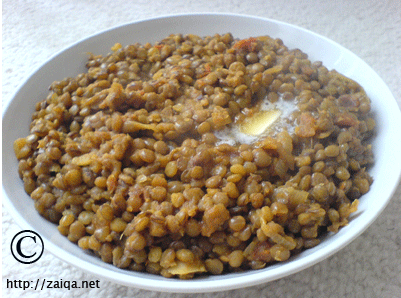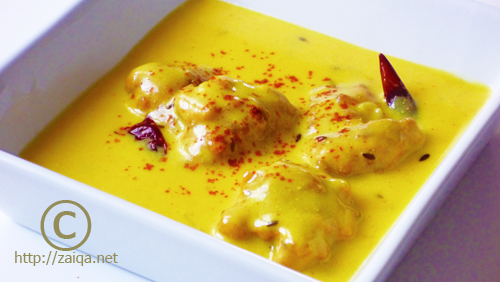Double Ka Meetha, also called as Dabal Ka Meetha, is one of the classic Nizami desserts ~ an eggless bread pudding, that hails from the city of Hyderabad, India. It also happens to be my miya‘s most favorite dessert. Atleast every once in a month I get a request from Ir saying, ‘Aaj double ka meetha banao na!’ (which means ‘Could you prepare Double Ka Meetha today?’). So, this weekend it was Double Ka Meetha at my house.
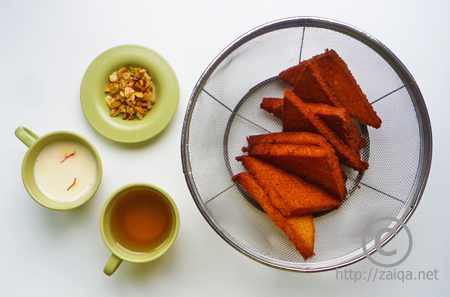
Clockwise from right ~ Fried Bread Triangles, Simple Sugar Syrup,
Thickened Milk with Saffron+Khoa, Fried mixed nuts
Some of you might wonder why this sweet dish is called as ‘Double Ka Meetha‘. Milk bread, also called as double roti, is especially bought from Rose Bakery in Hyderabad, and this bread is used to prepare this famous meetha . The bread is called as double roti or dabal roti, because the dough expands to double its size due to the action of yeast, and roti in Urdu language means ‘bread’. So its double roti, and the meetha is called as Double Ka Meetha or Dabal Ka Meetha. This dessert is also referred to as a ‘King of Bread Puddings’. It is served usually at weddings in Hyderabad and is an important dessert reserved for festivals, celebrations and on other special occasions. This meetha is an evolved version of the Lucknowi Shahi Tukde, which is more rich and heavier kind of this meetha.
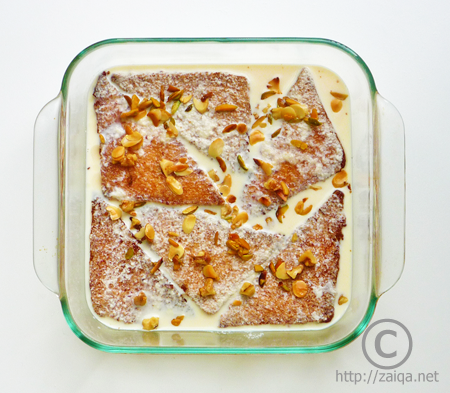
Fried bread striangles soaking up the sugar syrup and flavored thickened milk, garnished with dry fruits and nuts
You can serve this meetha when warm, some even prefer it chilled, it is up to ones own liking.
Hyderabadi Double Ka Meetha – Milk Bread Pudding with Nuts
Serves: 6-8
Ingredients:
Milk Bread Slices – 4
Canola Oil – to deep fry (traditionally ghee is used to deep fry)
Dry fruits and Nuts (cashewnuts-halved, raisins, pistachois, deseded dates, walnuts-chopped, almonds-chopped, pinenuts-chopped) – 4 tbsp
Milk – 2 cups
Homemade Khoa – 1/4 cup, grated (khoa is also available in most of Indian stores in the refrigerated section)
Cardamom Powder – 1/8 tsp
Saffron threads – a pinch
Water – 1 cup
White Sugar – 1 cup
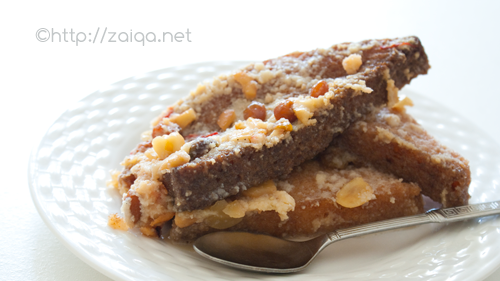
Double ka Meetha
Method:
1. Fry bread slices and dry fruits and nuts: Cut off the corners of the bread slices and slice them into triangles. Deep fry them both sides in oil till they are dark brown but not burnt. Remove the fried crisp bread slices using a slotten spoon onto a wire mesh strainer for the excess oil to drip off. In a small frying pan, in about a teaspoon of oil, stir fry the dry fruits and nuts till they are browned. Do not burn them. Keep aside.
2. Prepare reduced spiced milk mixture: In a milk sauce pan, pour milk and let it boil once on high heat. Once it has come to a boil, add khoa, lower the heat, and let it cook till it has reduced to half its original quantity, throw in the saffron threads and cardamom powder and keep aside.
3. Prepare sugar syrup: At the same time in an another small saucepan, pour the water and the sugar. Stir to dissolve and let the water boil on high for 10-12 minutes.
4. In a wide non-stick pan, arrange the fried bread slices, and sprinkle the stir fried dry fruits and nuts all over them. Gently pour the prepared warm simple sugar syrup and the warm reduced spiced milk into all over the arranged fried bread slices in the pan. Cook on high until boiling, then reduce the heat to simmer and cook until the liquid has been evaporated. During this time, you can very gently move the pieces whithout breaking them. Some people like to have this meetha warm, and some like it chilled. I let it cool down and then refrigerate it for a while and serve it chilled.
Oven Method:
1. Follow the step 1 to step 3 above.
2. In a wide baking dish, arrange the fried bread slices, and sprinkle the stir fried dry fruits and nuts all over them. Gently pour the prepared warm simple sugar syrup and the warm reduced spiced milk a little at a time one by one into the baking dish with the arranged fried bread slices. Now keep the dish aside for about 2-3 hours, until it has completely cooled down and the bread has almost absorbed all the milk. If there’s still some milk around the bread slices, and the bread has not completely absorbed it, then put the baking dish in the oven at 350°C for about 10-15 minutes, uncovered, in the middle rack. Some people like to have this meetha warm, and some like it cool. I let the baking dish cool down and then refrigerate it for a while and serve it chilled.
Note: In step 2, instead of boiling milk to half its original quantity, you can simply use 1 1/2 cup half and half, or light cream and add khoa, cardamom powder and saffron threads and boil it for a few minutes to dissolve the khoa. Keep stirring and do not burn. Continue with next step.
Enjoy this authentic Hyderabadi Bread Pudding.
This recipe is also being featured in the HomeAway.co.uk Travel Cookbook.
Luv,
Mona
